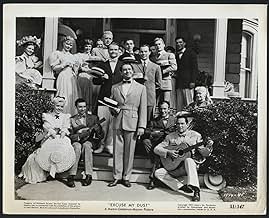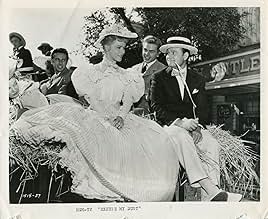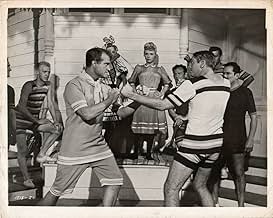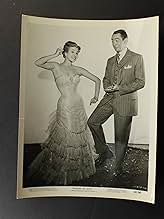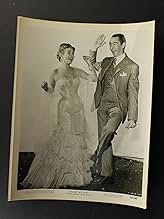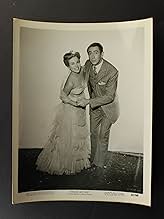CALIFICACIÓN DE IMDb
6.0/10
435
TU CALIFICACIÓN
En 1895, un inventor de pueblo enfrenta burlas por su auto a gasolina. Su novia lo apoya, pero el éxito trae complicaciones románticas. Durante una carrera de vehículos sin caballos, necesit... Leer todoEn 1895, un inventor de pueblo enfrenta burlas por su auto a gasolina. Su novia lo apoya, pero el éxito trae complicaciones románticas. Durante una carrera de vehículos sin caballos, necesita la ayuda de ella.En 1895, un inventor de pueblo enfrenta burlas por su auto a gasolina. Su novia lo apoya, pero el éxito trae complicaciones románticas. Durante una carrera de vehículos sin caballos, necesita la ayuda de ella.
- Dirección
- Guionistas
- Elenco
Herbert Anderson
- Ben Parrott
- (as Guy Anderson)
Jessie Arnold
- Woman on Street
- (sin créditos)
Polly Bailey
- Woman on Street
- (sin créditos)
Opiniones destacadas
In reviewing the so-called golden age of the MGM musical, sometimes it's instructive to bypass the big, accomplished, but pretentious famous titles (An American In Paris, The Band Wagon, On the Town, Kismet) and skip to the smaller movies produced by someone other than Arthur Freed. This 1951 tuner from the Jack Cummings unit is probably Red Skelton's best movie, which may not be saying much, but it's a very smart and pleasing little musical that doesn't wear out its welcome (it's a trim 80 minutes or so). Red's dopey slapstick is kept to a minimum (just two set pieces, at the beginning and the end), and what's in between is surprisingly gentle and well-written Americana -- in sunny Technicolor. The underrated score, by Dorothy Fields and Arthur Schwartz (who wrote another wonderful score for Broadway that year, the equally underrated "A Tree Grows In Brooklyn"), is solidly integrated into the plot, and the musical staging, by Hermes Pan, is bright and inventive. (The movie contains what may be the least plot-motivated "dream ballet" ever, but even it's quick and unpretentious.) Sally Forrest is pretty as a picture and a heck of a dancer, and Monica Lewis socks two comedy numbers across. They will help you past the dum-dum physical comedy that was Skelton's stock in trade.
It's no award-winner, nor did it do much at the box office, but it holds up much better than some of the bigger, weightier MGM titles.
It's no award-winner, nor did it do much at the box office, but it holds up much better than some of the bigger, weightier MGM titles.
MGM was never a good studio for slapstick comedians, but this time they got it right. Red Skelton had the misfortune to appear in a group of inept comedies for MGM which missed the mark for the most part. This comedy is terrific and Skelton is terrific in it. The comedy is set at the turn of the 20th Century with Skelton as an ambitious, but accident prone, inventor working on an early automobile. Although he is not given much in the way of witty dialogue, he is given ample opportunity to show his physical comedy skills. Although he plays a misunderstood dreamer, Skelton does not play a total nincompoop. While still a mugging comedian, he is likable and sympathetic. The supporting cast is just right with Macdonald Carey as Skelton's rival, Herbert Anderson as Skelton's straight man, Sally Forrest as his love interest and supporting character actors William Demarest and Raymond Walburn adding to the comedy. Monica Lewis is cast as the soubrette and is given two clever specialty numbers by Arthur Schwartz and Dorothy Fields. Forrest is given a good dance specialty. Skelton gets to sing the best song in the score, "Spring Has Sprung". The screenplay contains some clever satire concerning the industrial age, and, of course, there is the obligatory auto race at the end of the picture. The Technicolor photography is beautiful, but it does not take away from the comedy. This is a really fine, feel good, slapstick opus.
Red Skelton is an inventor in a small town in Indiana in 1895, anxious to invent a working automobile. He and Sally Forrest are in love. She is the daughter of William Demarest, the owner of a livery stable. His principal rival is Macdonald Carey. It all ends with a marvelous race among competing motorists that was directed by Buster Keaton, although Roy Rowland is the credited director.
There are various anachronisms that set my teeth on edge, like the use of the word "jass" -- for early jazz music. In reality, the word can't be traced back earlier than about 1912, and then it was in reference to baseball. Likewise, Miss Forrest is given a modern dance number, shoehorned into a dream sequence. If it seems to bear a relationship to the "Girl Hunt" number from THE BAND WAGON, well, Arthur Schwartz provided the music for three songs (with Dorothy Fields writing the lyrics) and Hermes Pan did the choreography.
There are fewer typical Red Skelton comic bits, but the final race is a fine series of comic disasters. By then, however, it was a little late in the show. Although it's worth watching, it's not one of Skelton's best starring vehicles. With Raymond Walburn, Jane Darwell, and Paul Harvey.
There are various anachronisms that set my teeth on edge, like the use of the word "jass" -- for early jazz music. In reality, the word can't be traced back earlier than about 1912, and then it was in reference to baseball. Likewise, Miss Forrest is given a modern dance number, shoehorned into a dream sequence. If it seems to bear a relationship to the "Girl Hunt" number from THE BAND WAGON, well, Arthur Schwartz provided the music for three songs (with Dorothy Fields writing the lyrics) and Hermes Pan did the choreography.
There are fewer typical Red Skelton comic bits, but the final race is a fine series of comic disasters. By then, however, it was a little late in the show. Although it's worth watching, it's not one of Skelton's best starring vehicles. With Raymond Walburn, Jane Darwell, and Paul Harvey.
I thought I was familiar with all of Red Skelton's movies. When I saw the title come up , I assumed it was Ron Howard's Eat My Dust. While I always liked Ron , I was excited to find out this was a Red movie I had not seen. I agree 100% with another review that said a different title was needed.
Yes , as a musical, not in the upper tier , but not many are. The dance scene's brought Sally Forrest to the fore. My goodness, had never heard of her , but she dances up a storm. The same with Monica Lewis in the singing department. Dennis the Menace's father , Herbert Anderson was good in an assistant role , and Macdonald Carey was good also. When William Demarest would yell at Red , it immediately took me back to him yelling at Ernie or Chip.
All in all , was surprised how much I enjoyed it. Give it a look.
Yes , as a musical, not in the upper tier , but not many are. The dance scene's brought Sally Forrest to the fore. My goodness, had never heard of her , but she dances up a storm. The same with Monica Lewis in the singing department. Dennis the Menace's father , Herbert Anderson was good in an assistant role , and Macdonald Carey was good also. When William Demarest would yell at Red , it immediately took me back to him yelling at Ernie or Chip.
All in all , was surprised how much I enjoyed it. Give it a look.
It's 1895 Willow Falls, Indiana. Inventor Joe Belden (Red Skelton) is creating his gasomobile. It's a horse-less carriage. Only, it never seems to work and he sets his own barn on fire. Liz Bullitt is his girlfriend. Her horse ranch owning father is opposed to him and prefers her other suitor Cyrus Ransom, Jr.
The biggest name in the credits seems to be Buster Keaton as an uncredited writer and director. I do wonder about the story behind the scene. There are a lot of cooks in this kitchen. I would probably work harder on getting better songs. They're ok but rather old fashion. They are songs from the late 19th century to the jazz age. Red Skelton is doing the good-natured goof without going too wacky. There is a car race at the end. It's not the most exciting, but it is interesting to see all the old cars. This is a nice lesser musical with little lasting effect.
The biggest name in the credits seems to be Buster Keaton as an uncredited writer and director. I do wonder about the story behind the scene. There are a lot of cooks in this kitchen. I would probably work harder on getting better songs. They're ok but rather old fashion. They are songs from the late 19th century to the jazz age. Red Skelton is doing the good-natured goof without going too wacky. There is a car race at the end. It's not the most exciting, but it is interesting to see all the old cars. This is a nice lesser musical with little lasting effect.
¿Sabías que…?
- TriviaThe original "Morgan" automobile in Soberbia (1942) was also used in this film.
- ErroresA few times during the race, wide tire tracks from more modern automobiles can be seen on the dirt roads.
- ConexionesFeatured in The Metro-Goldwyn-Mayer Story (1951)
- Bandas sonorasI'd Like to Take You Out Dreaming
Music by Arthur Schwartz
Lyrics by Dorothy Fields
Performed by Macdonald Carey and Chorus
Selecciones populares
Inicia sesión para calificar y agrega a la lista de videos para obtener recomendaciones personalizadas
Detalles
Taquilla
- Presupuesto
- USD 1,789,000 (estimado)
- Tiempo de ejecución
- 1h 22min(82 min)
- Relación de aspecto
- 1.37 : 1
Contribuir a esta página
Sugiere una edición o agrega el contenido que falta



